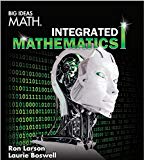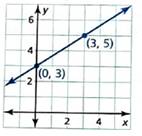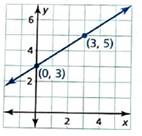
BIG IDEAS MATH Integrated Math 1: Student Edition 2016
16th Edition
ISBN: 9781680331127
Author: HOUGHTON MIFFLIN HARCOURT
Publisher: Houghton Mifflin Harcourt
expand_more
expand_more
format_list_bulleted
Concept explainers
Question
Chapter 4, Problem 1CR
To determine
To calculate: To write the equation of line in slope intercept form
Expert Solution & Answer
Answer to Problem 1CR
Equation of line in slope intercept form is
Explanation of Solution
Given: Graph of line is

Formula Used:
Equation of line in slope intercept form is given as:
Also, equation of line passing through two points is given as
Calculation:
Given the graph of line as follows:

From graph, line passes through the points
Thus, equation of line is calculated as follows:
Substituting the values:
Conclusion:
Hence, equation of line in slope intercept form is
Want to see more full solutions like this?
Subscribe now to access step-by-step solutions to millions of textbook problems written by subject matter experts!
Chapter 4 Solutions
BIG IDEAS MATH Integrated Math 1: Student Edition 2016
Ch. 4.1 - Prob. 1ECh. 4.1 - Prob. 2ECh. 4.1 - Prob. 3ECh. 4.1 - Prob. 4ECh. 4.1 - Prob. 5ECh. 4.1 - Prob. 6ECh. 4.1 - Prob. 7ECh. 4.1 - Prob. 8ECh. 4.1 - Prob. 9ECh. 4.1 - Prob. 10E
Ch. 4.1 - Prob. 11ECh. 4.1 - Prob. 12ECh. 4.1 - Prob. 13ECh. 4.1 - Prob. 14ECh. 4.1 - Prob. 15ECh. 4.1 - Prob. 16ECh. 4.1 - Prob. 17ECh. 4.1 - Prob. 18ECh. 4.1 - Prob. 19ECh. 4.1 - Prob. 20ECh. 4.1 - Prob. 21ECh. 4.1 - Prob. 22ECh. 4.1 - Prob. 23ECh. 4.1 - Prob. 24ECh. 4.1 - Prob. 25ECh. 4.1 - Prob. 26ECh. 4.1 - Prob. 27ECh. 4.1 - Prob. 28ECh. 4.1 - Prob. 29ECh. 4.1 - Prob. 30ECh. 4.1 - Prob. 31ECh. 4.1 - Prob. 32ECh. 4.1 - Prob. 33ECh. 4.1 - Prob. 34ECh. 4.1 - Prob. 35ECh. 4.1 - Prob. 36ECh. 4.1 - Prob. 37ECh. 4.1 - Prob. 38ECh. 4.1 - Prob. 39ECh. 4.1 - Prob. 40ECh. 4.1 - Prob. 41ECh. 4.1 - Prob. 42ECh. 4.1 - Prob. 43ECh. 4.1 - Prob. 44ECh. 4.1 - Prob. 45ECh. 4.2 - Prob. 1ECh. 4.2 - Prob. 2ECh. 4.2 - Prob. 3ECh. 4.2 - Prob. 4ECh. 4.2 - Prob. 5ECh. 4.2 - Prob. 6ECh. 4.2 - Prob. 7ECh. 4.2 - Prob. 8ECh. 4.2 - Prob. 9ECh. 4.2 - Prob. 10ECh. 4.2 - Prob. 11ECh. 4.2 - Prob. 12ECh. 4.2 - Prob. 13ECh. 4.2 - Prob. 14ECh. 4.2 - Prob. 15ECh. 4.2 - Prob. 16ECh. 4.2 - Prob. 17ECh. 4.2 - Prob. 18ECh. 4.2 - Prob. 19ECh. 4.2 - Prob. 20ECh. 4.2 - Prob. 21ECh. 4.2 - Prob. 22ECh. 4.2 - Prob. 23ECh. 4.2 - Prob. 24ECh. 4.2 - Prob. 25ECh. 4.2 - Prob. 26ECh. 4.2 - Prob. 27ECh. 4.2 - Prob. 28ECh. 4.2 - Prob. 29ECh. 4.2 - Prob. 30ECh. 4.2 - Prob. 31ECh. 4.2 - Prob. 32ECh. 4.2 - Prob. 33ECh. 4.2 - Prob. 34ECh. 4.2 - Prob. 35ECh. 4.2 - Prob. 36ECh. 4.2 - Prob. 37ECh. 4.2 - Prob. 38ECh. 4.2 - Prob. 39ECh. 4.2 - Prob. 40ECh. 4.2 - Prob. 41ECh. 4.2 - Prob. 42ECh. 4.2 - Prob. 43ECh. 4.2 - Prob. 44ECh. 4.3 - Prob. 1ECh. 4.3 - Prob. 2ECh. 4.3 - Prob. 3ECh. 4.3 - Prob. 4ECh. 4.3 - Prob. 5ECh. 4.3 - Prob. 6ECh. 4.3 - Prob. 7ECh. 4.3 - Prob. 8ECh. 4.3 - Prob. 9ECh. 4.3 - Prob. 10ECh. 4.3 - Prob. 11ECh. 4.3 - Prob. 12ECh. 4.3 - Prob. 13ECh. 4.3 - Prob. 14ECh. 4.3 - Prob. 15ECh. 4.3 - Prob. 16ECh. 4.3 - Prob. 17ECh. 4.3 - Prob. 18ECh. 4.3 - Prob. 19ECh. 4.3 - Prob. 20ECh. 4.3 - Prob. 21ECh. 4.3 - Prob. 22ECh. 4.3 - Prob. 23ECh. 4.3 - Prob. 24ECh. 4.3 - Prob. 25ECh. 4.3 - Prob. 26ECh. 4.3 - Prob. 27ECh. 4.3 - Prob. 28ECh. 4.3 - Prob. 29ECh. 4.3 - Prob. 30ECh. 4.3 - Prob. 31ECh. 4.3 - Prob. 32ECh. 4.3 - Prob. 33ECh. 4.3 - Prob. 34ECh. 4.3 - Prob. 35ECh. 4.3 - Prob. 36ECh. 4.3 - Prob. 37ECh. 4.3 - Prob. 38ECh. 4.3 - Prob. 1QCh. 4.3 - Prob. 2QCh. 4.3 - Prob. 3QCh. 4.3 - Prob. 4QCh. 4.3 - Prob. 5QCh. 4.3 - Prob. 6QCh. 4.3 - Prob. 7QCh. 4.3 - Prob. 8QCh. 4.3 - Prob. 9QCh. 4.3 - Prob. 10QCh. 4.3 - Prob. 11QCh. 4.3 - Prob. 12QCh. 4.3 - Prob. 13QCh. 4.3 - Prob. 14QCh. 4.3 - Prob. 15QCh. 4.3 - Prob. 16QCh. 4.4 - Prob. 1ECh. 4.4 - Prob. 2ECh. 4.4 - Prob. 3ECh. 4.4 - Prob. 4ECh. 4.4 - Prob. 5ECh. 4.4 - Prob. 6ECh. 4.4 - Prob. 7ECh. 4.4 - Prob. 8ECh. 4.4 - Prob. 9ECh. 4.4 - Prob. 10ECh. 4.4 - Prob. 11ECh. 4.4 - Prob. 12ECh. 4.4 - Prob. 13ECh. 4.4 - Prob. 14ECh. 4.4 - Prob. 15ECh. 4.4 - Prob. 16ECh. 4.4 - Prob. 17ECh. 4.4 - Prob. 18ECh. 4.4 - Prob. 19ECh. 4.4 - Prob. 20ECh. 4.4 - Prob. 21ECh. 4.4 - Prob. 22ECh. 4.4 - Prob. 23ECh. 4.4 - Prob. 24ECh. 4.4 - Prob. 25ECh. 4.4 - Prob. 26ECh. 4.4 - Prob. 27ECh. 4.4 - Prob. 28ECh. 4.5 - Prob. 1ECh. 4.5 - Prob. 2ECh. 4.5 - Prob. 3ECh. 4.5 - Prob. 4ECh. 4.5 - Prob. 5ECh. 4.5 - Prob. 6ECh. 4.5 - Prob. 7ECh. 4.5 - Prob. 8ECh. 4.5 - Prob. 9ECh. 4.5 - Prob. 10ECh. 4.5 - Prob. 11ECh. 4.5 - Prob. 12ECh. 4.5 - Prob. 13ECh. 4.5 - Prob. 14ECh. 4.5 - Prob. 15ECh. 4.5 - Prob. 16ECh. 4.5 - Prob. 17ECh. 4.5 - Prob. 18ECh. 4.5 - Prob. 19ECh. 4.5 - Prob. 20ECh. 4.5 - Prob. 21ECh. 4.5 - Prob. 22ECh. 4.5 - Prob. 23ECh. 4.5 - Prob. 24ECh. 4.5 - Prob. 25ECh. 4.5 - Prob. 26ECh. 4.5 - Prob. 27ECh. 4.5 - Prob. 28ECh. 4.5 - Prob. 29ECh. 4.5 - Prob. 30ECh. 4.5 - Prob. 31ECh. 4.5 - Prob. 32ECh. 4.5 - Prob. 33ECh. 4.6 - Prob. 1ECh. 4.6 - Prob. 2ECh. 4.6 - Prob. 3ECh. 4.6 - Prob. 4ECh. 4.6 - Prob. 5ECh. 4.6 - Prob. 6ECh. 4.6 - Prob. 7ECh. 4.6 - Prob. 8ECh. 4.6 - Prob. 9ECh. 4.6 - Prob. 10ECh. 4.6 - Prob. 11ECh. 4.6 - Prob. 12ECh. 4.6 - Prob. 13ECh. 4.6 - Prob. 14ECh. 4.6 - Prob. 15ECh. 4.6 - Prob. 16ECh. 4.6 - Prob. 17ECh. 4.6 - Prob. 18ECh. 4.6 - Prob. 19ECh. 4.6 - Prob. 20ECh. 4.6 - Prob. 21ECh. 4.6 - Prob. 22ECh. 4.6 - Prob. 23ECh. 4.6 - Prob. 24ECh. 4.6 - Prob. 25ECh. 4.6 - Prob. 26ECh. 4.6 - Prob. 27ECh. 4.6 - Prob. 28ECh. 4.6 - Prob. 29ECh. 4.6 - Prob. 30ECh. 4.6 - Prob. 31ECh. 4.6 - Prob. 32ECh. 4.6 - Prob. 33ECh. 4.6 - Prob. 34ECh. 4.6 - Prob. 35ECh. 4.6 - Prob. 36ECh. 4.6 - Prob. 37ECh. 4.6 - Prob. 38ECh. 4.6 - Prob. 39ECh. 4.6 - Prob. 40ECh. 4.6 - Prob. 41ECh. 4.6 - Prob. 42ECh. 4.6 - Prob. 43ECh. 4.6 - Prob. 44ECh. 4.6 - Prob. 45ECh. 4.6 - Prob. 46ECh. 4.6 - Prob. 47ECh. 4.6 - Prob. 48ECh. 4.6 - Prob. 49ECh. 4.6 - Prob. 50ECh. 4.6 - Prob. 51ECh. 4.6 - Prob. 52ECh. 4.6 - Prob. 53ECh. 4.6 - Prob. 54ECh. 4.6 - Prob. 55ECh. 4.6 - Prob. 56ECh. 4.6 - Prob. 57ECh. 4.6 - Prob. 58ECh. 4.6 - Prob. 59ECh. 4.6 - Prob. 60ECh. 4.6 - Prob. 61ECh. 4.6 - Prob. 62ECh. 4.6 - Prob. 63ECh. 4.6 - Prob. 64ECh. 4.6 - Prob. 65ECh. 4 - Prob. 1CRCh. 4 - Prob. 2CRCh. 4 - Prob. 3CRCh. 4 - Prob. 4CRCh. 4 - Prob. 5CRCh. 4 - Prob. 6CRCh. 4 - Prob. 7CRCh. 4 - Prob. 8CRCh. 4 - Prob. 9CRCh. 4 - Prob. 10CRCh. 4 - Prob. 11CRCh. 4 - Prob. 12CRCh. 4 - Prob. 13CRCh. 4 - Prob. 14CRCh. 4 - Prob. 15CRCh. 4 - Prob. 16CRCh. 4 - Prob. 17CRCh. 4 - Prob. 18CRCh. 4 - Prob. 19CRCh. 4 - Prob. 20CRCh. 4 - Prob. 21CRCh. 4 - Prob. 22CRCh. 4 - Prob. 23CRCh. 4 - Prob. 24CRCh. 4 - Prob. 25CRCh. 4 - Prob. 26CRCh. 4 - Prob. 27CRCh. 4 - Prob. 28CRCh. 4 - Prob. 29CRCh. 4 - Prob. 30CRCh. 4 - Prob. 1CTCh. 4 - Prob. 2CTCh. 4 - Prob. 3CTCh. 4 - Prob. 4CTCh. 4 - Prob. 5CTCh. 4 - Prob. 6CTCh. 4 - Prob. 7CTCh. 4 - Prob. 8CTCh. 4 - Prob. 9CTCh. 4 - Prob. 10CTCh. 4 - Prob. 11CTCh. 4 - Prob. 12CTCh. 4 - Prob. 13CTCh. 4 - Prob. 1CACh. 4 - Prob. 2CACh. 4 - Prob. 3CACh. 4 - Prob. 4CACh. 4 - Prob. 5CACh. 4 - Prob. 6CACh. 4 - Prob. 7CACh. 4 - Prob. 8CACh. 4 - Prob. 9CA
Knowledge Booster
Learn more about
Need a deep-dive on the concept behind this application? Look no further. Learn more about this topic, subject and related others by exploring similar questions and additional content below.Similar questions
- - Suppose that you have the differential equation: dy = (y - 2) (y+3) dx a. What are the equilibrium solutions for the differential equation? b. Where is the differential equation increasing or decreasing? Show how you know. Showing them on the drawing is not enough. c. Where are the changes in concavity for the differential equation? Show how you know. Showing them on the drawing is not enough. d. Consider the slope field for the differential equation. Draw solution curves given the following initial conditions: i. y(0) = -5 ii. y(0) = -1 iii. y(0) = 2arrow_forward5. Suppose that a mass of 5 stretches a spring 10. The mass is acted on by an external force of F(t)=10 sin () and moves in a medium that gives a damping coefficient of ½. If the mass is set in motion with an initial velocity of 3 and is stretched initially to a length of 5. (I purposefully removed the units- don't worry about them. Assume no conversions are needed.) a) Find the equation for the displacement of the spring mass at time t. b) Write the equation for the displacement of the spring mass in phase-mode form. c) Characterize the damping of the spring mass system as overdamped, underdamped or critically damped. Explain how you know. D.E. for Spring Mass Systems k m* g = kLo y" +—y' + — —±y = —±F(t), y(0) = yo, y'(0) = vo m 2 A₁ = √c₁² + C₂² Q = tan-1arrow_forward4. Given the following information determine the appropriate trial solution to find yp. Do not solve the differential equation. Do not find the constants. a) (D-4)2(D+ 2)y = 4e-2x b) (D+ 1)(D² + 10D +34)y = 2e-5x cos 3xarrow_forward
- 9.7 Given the equations 0.5x₁-x2=-9.5 1.02x₁ - 2x2 = -18.8 (a) Solve graphically. (b) Compute the determinant. (c) On the basis of (a) and (b), what would you expect regarding the system's condition? (d) Solve by the elimination of unknowns. (e) Solve again, but with a modified slightly to 0.52. Interpret your results.arrow_forward3. Determine the appropriate annihilator for the given F(x). a) F(x) = 5 cos 2x b) F(x)=9x2e3xarrow_forward12.42 The steady-state distribution of temperature on a heated plate can be modeled by the Laplace equation, 0= FT T + 200°C 25°C 25°C T22 0°C T₁ T21 200°C FIGURE P12.42 75°C 75°C 00°C If the plate is represented by a series of nodes (Fig. P12.42), cen- tered finite-divided differences can be substituted for the second derivatives, which results in a system of linear algebraic equations. Use the Gauss-Seidel method to solve for the temperatures of the nodes in Fig. P12.42.arrow_forward
- 9.22 Develop, debug, and test a program in either a high-level language or a macro language of your choice to solve a system of equations with Gauss-Jordan elimination without partial pivoting. Base the program on the pseudocode from Fig. 9.10. Test the program using the same system as in Prob. 9.18. Compute the total number of flops in your algorithm to verify Eq. 9.37. FIGURE 9.10 Pseudocode to implement the Gauss-Jordan algorithm with- out partial pivoting. SUB GaussJordan(aug, m, n, x) DOFOR k = 1, m d = aug(k, k) DOFOR j = 1, n aug(k, j) = aug(k, j)/d END DO DOFOR 1 = 1, m IF 1 % K THEN d = aug(i, k) DOFOR j = k, n aug(1, j) END DO aug(1, j) - d*aug(k, j) END IF END DO END DO DOFOR k = 1, m x(k) = aug(k, n) END DO END GaussJordanarrow_forward11.9 Recall from Prob. 10.8, that the following system of equations is designed to determine concentrations (the e's in g/m³) in a series of coupled reactors as a function of amount of mass input to each reactor (the right-hand sides are in g/day): 15c3cc33300 -3c18c26c3 = 1200 -4c₁₂+12c3 = 2400 Solve this problem with the Gauss-Seidel method to & = 5%.arrow_forward9.8 Given the equations 10x+2x2-x3 = 27 -3x-6x2+2x3 = -61.5 x1 + x2 + 5x3 = -21.5 (a) Solve by naive Gauss elimination. Show all steps of the compu- tation. (b) Substitute your results into the original equations to check your answers.arrow_forward
- Tangent planes Find an equation of the plane tangent to the following surfaces at the given points (two planes and two equations).arrow_forwardVectors u and v are shown on the graph.Part A: Write u and v in component form. Show your work. Part B: Find u + v. Show your work.Part C: Find 5u − 2v. Show your work.arrow_forwardVectors u = 6(cos 60°i + sin60°j), v = 4(cos 315°i + sin315°j), and w = −12(cos 330°i + sin330°j) are given. Use exact values when evaluating sine and cosine.Part A: Convert the vectors to component form and find −7(u • v). Show every step of your work.Part B: Convert the vectors to component form and use the dot product to determine if u and w are parallel, orthogonal, or neither. Justify your answer.arrow_forward
arrow_back_ios
SEE MORE QUESTIONS
arrow_forward_ios
Recommended textbooks for you
 Discrete Mathematics and Its Applications ( 8th I...MathISBN:9781259676512Author:Kenneth H RosenPublisher:McGraw-Hill Education
Discrete Mathematics and Its Applications ( 8th I...MathISBN:9781259676512Author:Kenneth H RosenPublisher:McGraw-Hill Education Mathematics for Elementary Teachers with Activiti...MathISBN:9780134392790Author:Beckmann, SybillaPublisher:PEARSON
Mathematics for Elementary Teachers with Activiti...MathISBN:9780134392790Author:Beckmann, SybillaPublisher:PEARSON
 Thinking Mathematically (7th Edition)MathISBN:9780134683713Author:Robert F. BlitzerPublisher:PEARSON
Thinking Mathematically (7th Edition)MathISBN:9780134683713Author:Robert F. BlitzerPublisher:PEARSON Discrete Mathematics With ApplicationsMathISBN:9781337694193Author:EPP, Susanna S.Publisher:Cengage Learning,
Discrete Mathematics With ApplicationsMathISBN:9781337694193Author:EPP, Susanna S.Publisher:Cengage Learning, Pathways To Math Literacy (looseleaf)MathISBN:9781259985607Author:David Sobecki Professor, Brian A. MercerPublisher:McGraw-Hill Education
Pathways To Math Literacy (looseleaf)MathISBN:9781259985607Author:David Sobecki Professor, Brian A. MercerPublisher:McGraw-Hill Education

Discrete Mathematics and Its Applications ( 8th I...
Math
ISBN:9781259676512
Author:Kenneth H Rosen
Publisher:McGraw-Hill Education

Mathematics for Elementary Teachers with Activiti...
Math
ISBN:9780134392790
Author:Beckmann, Sybilla
Publisher:PEARSON


Thinking Mathematically (7th Edition)
Math
ISBN:9780134683713
Author:Robert F. Blitzer
Publisher:PEARSON

Discrete Mathematics With Applications
Math
ISBN:9781337694193
Author:EPP, Susanna S.
Publisher:Cengage Learning,

Pathways To Math Literacy (looseleaf)
Math
ISBN:9781259985607
Author:David Sobecki Professor, Brian A. Mercer
Publisher:McGraw-Hill Education
Points, Lines, Planes, Segments, & Rays - Collinear vs Coplanar Points - Geometry; Author: The Organic Chemistry Tutor;https://www.youtube.com/watch?v=dDWjhRfBsKM;License: Standard YouTube License, CC-BY
Naming Points, Lines, and Planes; Author: Florida PASS Program;https://www.youtube.com/watch?v=F-LxiLSSaLg;License: Standard YouTube License, CC-BY